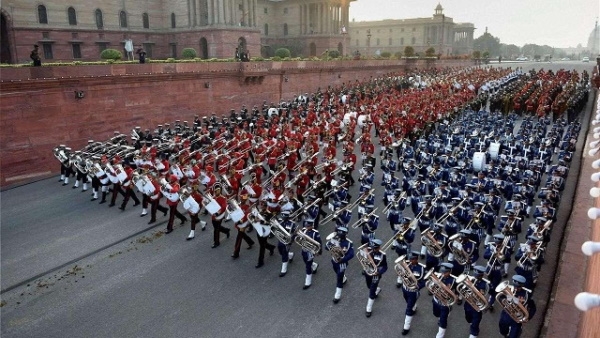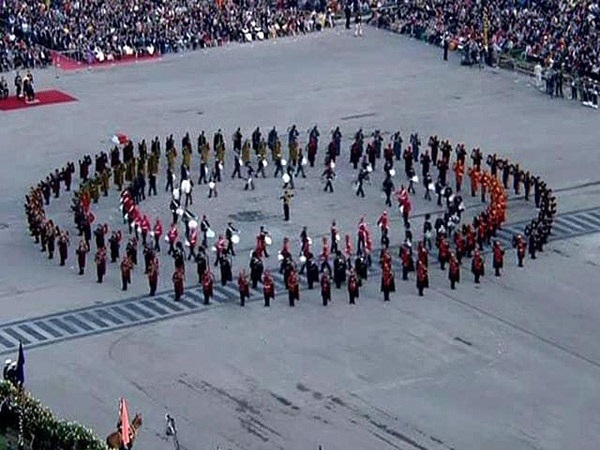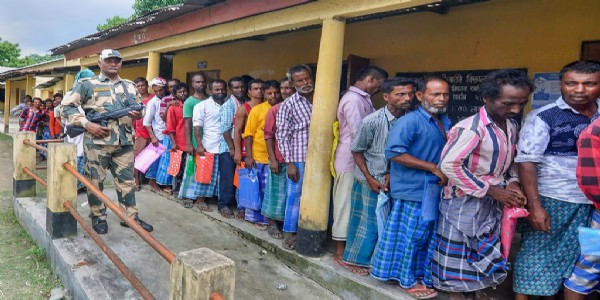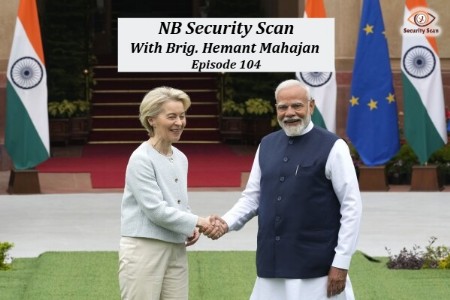Beating Retreat Gets an Indian Touch
Total Views | 89
Whereas the Republic Day Parade demonstrates the military prowess and cultural heritage of India, the ceremony of beating retreat at Vijay Chowk marks the end of the celebrations. A number of changes were introduced in Beating Retreat 2016. Yes, ‘beating retreat’ is the correct taxonomy. It is wrongly called as ‘beating the retreat’ or ‘beating of the retreat’.
Beating Retreat is undoubtedly a military ceremony and owes its origin to the English practice of calling back all soldiers and citizens to the safety of the citadels/forts/fortifications before the night set in. It also marked the commencement of the night shift of sentries on the ramparts. The practice dates back to the 16th century. Initially, calls were made either by firing a single shot from the evening gun or by the drummers. Later, buglers joined them for wider area coverage. Over a period of time, the practice lost its battlefield relevance and got converted into a ceremonial event with massed band display.

Interestingly, even during the epic battle of Mahabharata, heads of the opposing armies used to blow their conches to mark the end of hostilities at sunset. It was Beating Retreat in the ancient mould. Bheeshma’s conch was called ‘Shashanka’ while ‘Anantvijay’ was the name given to that of Yudhisthira. Their conches had distinct sound characteristics for easy recognition by the soldiers. As per the mutually agreed rules of combat, no fighting was to take place between sunset and sunrise. The break was utilized to treat the wounded, cremate the dead, exchange prisoners of war, take stock of the day’s events, and strategize for the next day’s battles.
Beating Retreat as a ceremony is a British legacy. Many countries of the erstwhile British Empire continued with the ceremony even after gaining independence. However, most have moved away from the original format: the marching of bands is accompanied by the firing of cannons, eye-catching props, and cultural presentations with background music. In many countries, the ceremony has already got transformed into a military concert or pageant or tattoo. Some have included fireworks display and field artillery gunfire. In Jordan, a camel mounted equestrian drill team is a key attraction of the Beating Retreat ceremony. Even in Britain, the occasion is now used to raise money for the Army Benevolent Fund. Since 2008, even foreign bands are invited to participate in the ceremony.
In India, the practice of having the Beating Retreat ceremony was started in 1950. While maintaining the conventional format of the ceremony, India has introduced a number of changes over the years. Many foreign tunes have been replaced by Indian patriotic, nationalist, and folk songs. Popular tunes from Indian films have also been added to the existing repertoire of rock, jazz and waltz pieces. Strategically placed tubular bells have been added to create a mesmerizing experience. As the changes were gradual, they went unnoticed and unopposed. Most conventionalists were happy as long as the basic contours of the ceremony retained their military-like character and the band movements followed the old traditional patterns.
However, Beating Retreat 2016 revealed an entirely fresh approach to the whole ceremony. It was a proud nation’s assertion of its heritage. India showcased to the world what had never been attempted before, i.e. a fusion of Western and Indian musical instruments in a military event. Traditional band instruments like bugle, saxophone, trumpet, cymbals, clarinet, trombone, drums and bagpipes coalesced with sitar, santoor and tabla to create an enthralling aura. In a significant departure from the conventional marching music, players of Indian instruments had to sit on ground to play their instruments.

In addition to 15 military bands and 18 pipes-and-drums bands from the army, both the air force and the navy provided one band each. Central Armed Police Forces and the Delhi Police bands also participated for the first time. Their coordinated movements produced a flawlessly executed massed band display with precision. Presence of the Indian Classical Instruments Sinfonietta and the Jazz Symphonic Orchestra added an entirely different dimension to the ceremony.
As was expected, above changes evoked conflicting response. The non-conventionalists viewed the alterations as a bold act of innovative creativity. For them, the new format was a praiseworthy attempt to contemporise a traditional military ceremony by blending it with India’s rich musical heritage. On the other hand, purists decried the changes. They considered them to be an unpardonable act of sacrilege and a deplorable dilution of military traditions. The critics faulted the new version on two counts. One, playing of symphonies (both western and Indian) and inclusion of Indian musical instruments. Two, inclusion of police bands in a purely military ceremony. Here is a critique of the issues raised.
It is not understood as to how inclusion of a few symphonies can eclipse the martial music. The ceremony retains its military spirit, lucidity and precision. As a matter of fact, inclusion of Indian instruments adds to the versatility and array of the ceremony. It is indeed a brilliant step. Strangely, while our ex-colonial masters have long abandoned the old format, our slavish mindset prevents us from giving the ceremony an Indian flavour. Scottish bagpipes are acceptable but not Indian musical instruments.
One is reminded of the stiff opposition put up by a section of traditionalists when the government decided to change the words of command to Hindi. They scoffed at the replacement of ‘Attention’ by ‘Savdhan’ and so on. Numerous jokes were concocted to ridicule the Hindi terms. Perhaps, centuries of enslavement makes countries wary of weaning themselves away from the practices taught by the erstwhile masters. They tend to shun their indigenous traditions.
Two, one wonders as to how the inclusion of the police bands dilutes the military character of the ceremony? It is a Republic Day function and not an Army Day show. Police forces are an integral and vital part of the national security apparatus. They do not have an adversarial relationship with the military. By including them in the ceremony, the army is helping them imbibe military values. In any case, the overall command and control of the ceremony remains totally in military hands.
India has a rich legacy of martial music with a wide variety of percussion and wind instruments. The earliest mention of wind instruments to convey war orders is found in Ramayan. It was called ‘Goshring’ (cow’s horn). In Rigved, it is referred to as Bakura. In the olden days, warriors used conches.
“To jerk his commanders out of their mental preoccupations and reservations, the great leader of the Kaurav army Bhishma took up his conch and blew it, sending forth roaring waves of confidence into the hearts of his troops. It was a battle cry that marked the beginning of the Great War” (Bhagwat Gita 1/12)
As the Indian ceremony enjoys an international viewership, it provides India an opportunity to showcase the nation’s rich heritage. The buglers can be complemented by ‘Ranbakura’, Rajasthan’s traditional wind instrument for calling soldiers to arms. Similarly, martial drums of the North East can be harmonized with the military drummers. Unfortunately, our education system has ingrained in us an acute sense of inferiority. We take pride in deriding ancient India’s intellectual prowess, liberal thinking, and cultural richness and multiplicity of philosophical elucidations.
Opposition to what is disparagingly called ‘the indigenization of Beating Retreat’ is in a similar vein. To deride own culture has been the hallmark of India’s intelligentsia. In fact, they appear to be apologetic of India’s rich heritage and ethnicity whereas no other country can boast of an ancient civilization with 10,000 years of recorded history.
It is agreed that the military character of the Beating Retreat ceremony should not be compromised. However, a fusion of conventional military movements and traditional Indian instruments will only add to the stature of the ceremony and inculcate a sense of national ascendancy. India gained Independence over seven decades ago. It is time the Westernised apologists shed the mental yoke of slavery and learn to take pride in own ancestry. For, ancestry can neither be disputed nor renounced. Masquerading as ‘cultural orphans’ can never be a matter of superciliousness.
Bharati Web






